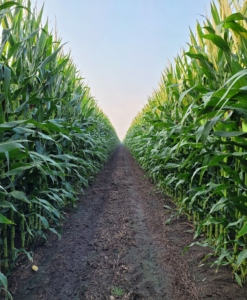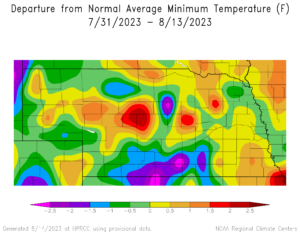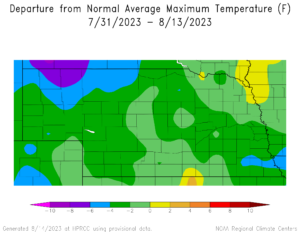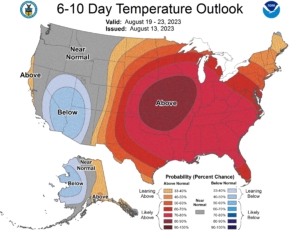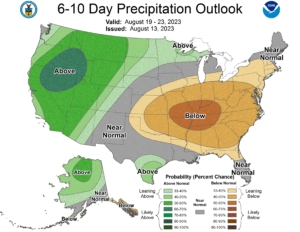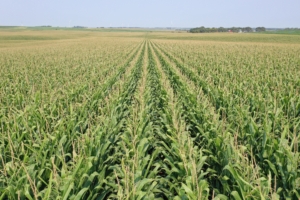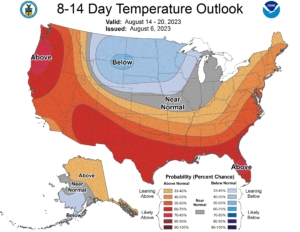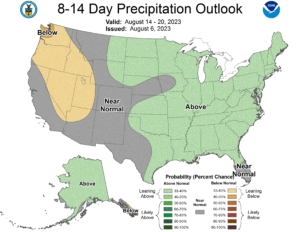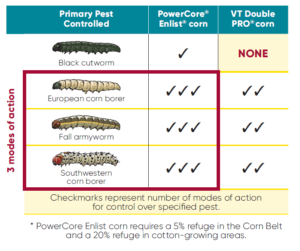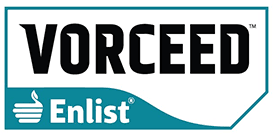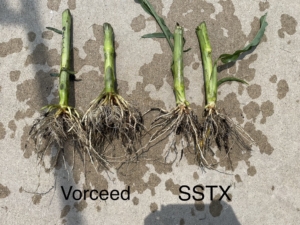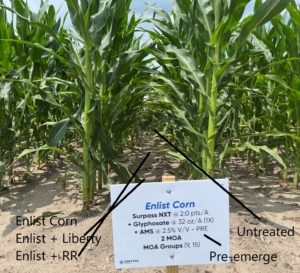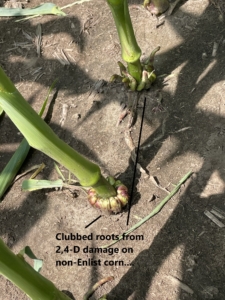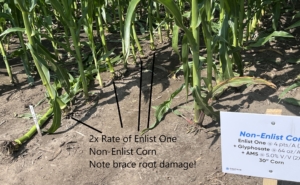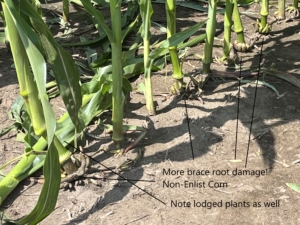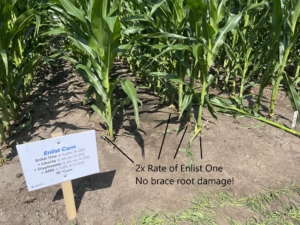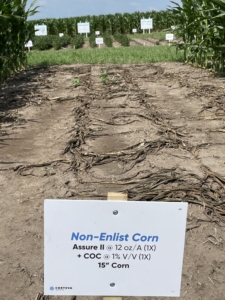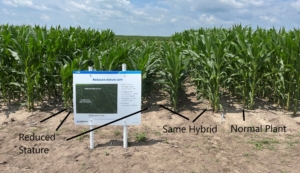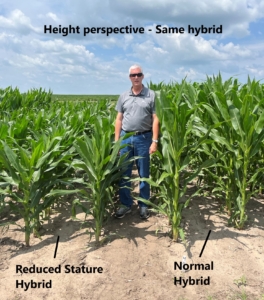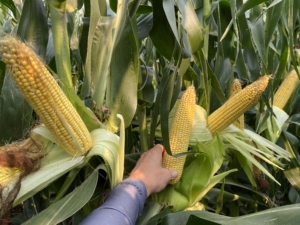
Often times the last 2 minutes of a football game decides the winner….so too, the last few weeks of the growing season are important to finishing the crop and getting the best yield possible…
Topics:
- Growing Degree Unit Update/Weather Forecast
- Crop Update – Water, Disease
TEMPERATURES & GDU ACCUMULATION:
As of August 30th, we have accumulated approximately the following for Growing Degree Units in 2023:
Planting Date GDD’s2023 Average GDD Departure from average
April 17 2602 2533 +69 (+ 3 days)
April 26 2558 2474 +84 (+ 4 days)
May 9 2427 2365 +62 (+ 3 days)
June 1 2064 2072 -8 (even)
The heat of the last two weeks has really moved things along. From being 2-3 days behind normal in the first half of August, we are now 3-4 day ahead, which means we have gained almost a week in GDU accumulation over the past two weeks. From the last update on August 22nd, we are averaging almost 25 GDu’s/day…normal is around 20-22/day for this time of year. Even the June planted crop has reached parity to normal. We are seeing this gain due to average high temperatures over this time period being 4-5 degrees above normal and average nightime temperatures averaging 2-3 degrees above normal. This also increased the amount of stress the crop has been under, compounded by lack of moisture….
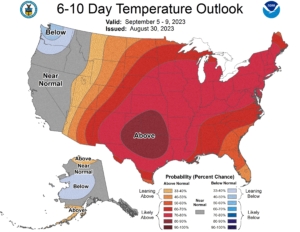
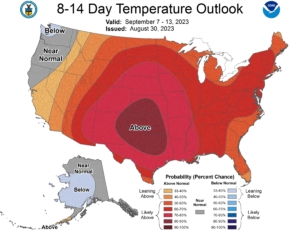

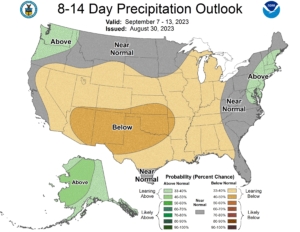
The above maps are the 6-10 and 8-14 day temperature and precipitation forecasts, published date is August 30th. Note that the forecast is for continued much above normal temps and normal to below normal precip. Keep in mind that normal September precip is around 2.5″ for the month. The crop will continue to progress quicker than average, which means harvest is fast-approaching….
Current Corn Conditions…..
- Much of the corn crop is as follows: April planting dates – 103-110 day hybrids at 1/4-2/3 milk lines with 112-118 day hybrids at 1/8 to 1/2. May planting dates are 1/4 to 1/3 for the most part. Majority of crop is 1/4 to 2/3 milk line. Interestingly, this is a little behind last year on stage-of-growth, even though we are even on GDU’s with 2022. I think this has to with the cold conditions at planting for most of April into early May. The crop sat in the ground for awhile; so even though GDU’s accumulated says the crop should be close to maturity, the crop itself is not as far along as GDU accumulation says it should be. This would be especially true on no-till vs. tilled soils. As an example, we were into a plot (108-112 day hybrids) this afternoon planted April 26th, no-tilled, and most hybrids were only 1/4 milk….
- Using the above GDU numbers, how do we shake out on GDU accumulation vs. crop progress? Using the April 26th planting date from above, we have accumulated enough GDU’s to black layer (by the book) many 103-106 day hybrids and even some early-silking mid-season hybrids. However, no field in the area is black-layered yet…even a field of P0622AML planted on April 17th, (which that figure is 50+ GDU’s over what the book says this hybrid should finish at) is only 2/3-3/4 milk line. GUD accumulation over the next 7-10 days should add 200+ GDU’s, which would be enough to finish out 112-116 day maturities. It is not uncommon to have the crop crop ‘stall out’ at 1/3-1/2 milk line and ‘sit’ so to speak. Usually this is good for yield, test weights, etc. The last few weeks of grain fill are important to test weight, grain quality and kernel depth. Keeping the comments in mind from the above first bullet point in mind, we are potentially looking at another 2 weeks of grain fill on many fields yet. However, will the heat of this weekend ‘push’ the crop too fast and will we get another two weeks….time will tell….
- Staygreen in the irrigated is holding up for now, but starting to see some ears droop on the irrigated. Most irrigated came through the heat of last week in pretty good shape, however, we will see what this weekend’s heat brings. Last week put stress on the crop regardless, it remains to be seen if more heat (and wind and low humidity) compounds the earlier heat and pushes the crop in some spots ‘over-the-edge’….
- Sunlight: Since last update, we have been running 6-8% above normal for solar radiation, this has been a positive to plant health and grain color (test weight). Overall, sunlight for 2023 grain fill has been similar to 2022 but the periods of sunlight have been at different time periods of the grain fill from year-to-year. Sunlight plays a huge role in grain yield (kernel size…test weight, etc.) and plant health. Having above normal sunlight is always a positive thing. The trend is positive for continued good sunlight to finish grain fill….
- Corn Disease: Since last update, relative humidity has been slightly below normal. This has helped keep corn diseases in check and has slowed down somewhat the White Mold in soybeans. Main corn diseases in corn right now are Goss’s Wilt in fields that saw the heaviest hail damage from July and Northern Corn Leaf Blight spreading in those hybrids that have low tolerance to this disease and were not treated with a fungicide earlier. Gray Leaf Spot has been very light so far. We have yet to find Tar Spot in area fields, but it would not surprise me if there was a little around. It was recently observed in Clay county Nebraska, which is the furthest west the disease has been found in NE so far.
- Soybean Disease: biggest disease issue in soybeans is White Mold. We are seeing the heaviest White Mold infestations since the mid-2010’s. Weather conditions in late-July and early-August are very important to how severe this disease will be. It is favored by wet, humid, cool conditions in late-July and early August…all of which we had during that time frame. in other words, environment was very conducive to the outbreak of this disease. The following maps will highlight this even more.
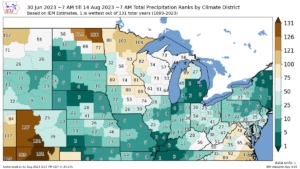
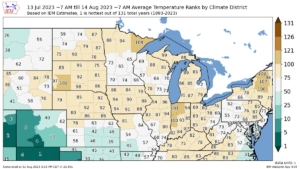 The first map shows the total precipitation by climate district from July 1 to August 14. From the map we can see that Northeast NE saw the 9th wettest out of the last 131 years during this time period….so first condition, wet, humid turned true (thankfully so though considering how dry we were before this and how dry we are now). The second map shows average temperature ranks by climate district. Here, Northeast NE saw the 92nd coolest period out of the last 131 years….second condition met…cool temps. All of this allowed for high development of this disease and increased potential for plant lodging which compounds things even further. Add this to a low tolerant variety and/or no fungicide application, and infestation levels turned out high. From our observations, timely applications of Aproach fungicide has offered good control and slowed the disease down. See photo….
The first map shows the total precipitation by climate district from July 1 to August 14. From the map we can see that Northeast NE saw the 9th wettest out of the last 131 years during this time period….so first condition, wet, humid turned true (thankfully so though considering how dry we were before this and how dry we are now). The second map shows average temperature ranks by climate district. Here, Northeast NE saw the 92nd coolest period out of the last 131 years….second condition met…cool temps. All of this allowed for high development of this disease and increased potential for plant lodging which compounds things even further. Add this to a low tolerant variety and/or no fungicide application, and infestation levels turned out high. From our observations, timely applications of Aproach fungicide has offered good control and slowed the disease down. See photo….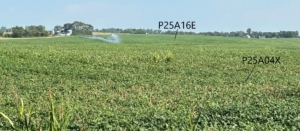 this photo shows P25A16E Enlist next to P25A04X Xtend soybeans. Two different growers but both fields side-by-side. P25A04X has good tolerance rating and that field was treated 2 times, but with a different product than Aproach. The P25A16E’s were treated twice at 9oz rate with Aproach. As you can see in the photo, the P25A16’s look green and clean compared to the A04’s. In heavy pressure White Mold years, what product one uses to give control is a very big deal….
this photo shows P25A16E Enlist next to P25A04X Xtend soybeans. Two different growers but both fields side-by-side. P25A04X has good tolerance rating and that field was treated 2 times, but with a different product than Aproach. The P25A16E’s were treated twice at 9oz rate with Aproach. As you can see in the photo, the P25A16’s look green and clean compared to the A04’s. In heavy pressure White Mold years, what product one uses to give control is a very big deal….- Watering: As one would expect, the heat of the last two weeks has increased ET rates. One only has to look at some area dryland to see that’s the case as well. For perspective, see the following map.
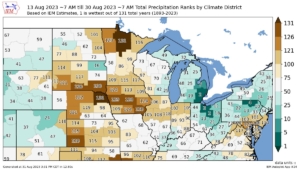 This map is the precipitation rank by climate district for the past two weeks. Northeast NE has had the driest on record for this time frame. Couple this with the above normal temps, and we can see why dryland has been hurt and starting to see ear droppage in some irrigated corn fields. Table below shows the approximate amount of water needed to reach maturity. Keep in mind that temperatures and Relative Humidity play a role in these amounts. We are still needing another circle into next week for most late-April, May planting dates…especially with the continued heat….
This map is the precipitation rank by climate district for the past two weeks. Northeast NE has had the driest on record for this time frame. Couple this with the above normal temps, and we can see why dryland has been hurt and starting to see ear droppage in some irrigated corn fields. Table below shows the approximate amount of water needed to reach maturity. Keep in mind that temperatures and Relative Humidity play a role in these amounts. We are still needing another circle into next week for most late-April, May planting dates…especially with the continued heat….
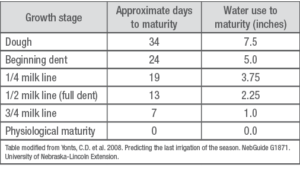
Current Soybean Conditions…..
- Soybeans are beginning to turn in much of the area, mainly the early-group II varieties. Much of the crop is in the late-R6 stage of growth. It is possible that some irrigated acres could be ready to harvest in the next 14 days if current weather conditions continue. Dryland corners are also turning fast now or almost finished depending upon area…keep these in mind for possible early harvest as well.
- Dectes Stem Borer.
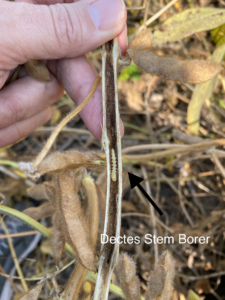 This insect enters the plant at a node and proceeds to ‘hollow out’ the stem leading to early plant death. So far not much one can do in the way of management for this insect yet. We saw a high incidence of this insect in our area a couple of years ago. Expectations are that we will have higher levels this year. Keep this in mind as harvest approaches….timely harvest will limit the economic impact of this insect.
This insect enters the plant at a node and proceeds to ‘hollow out’ the stem leading to early plant death. So far not much one can do in the way of management for this insect yet. We saw a high incidence of this insect in our area a couple of years ago. Expectations are that we will have higher levels this year. Keep this in mind as harvest approaches….timely harvest will limit the economic impact of this insect. - For more info see the following link….Dectes Stem Borer in Soybeans
- The picture below shows the stage of growth for early R6 soybeans through R7. The chart below shows water needs to finish for soybeans. Most fields are in the R6.5 to R6.8 stage at present which still means 2-3″ of water to finish. Soybeans are still pulling harder than corn right now.
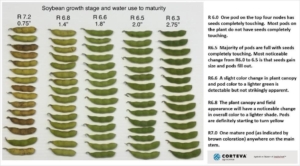
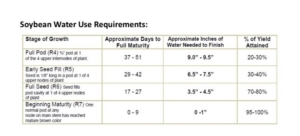
New Corn/Soybeans from Pioneer:
 The photo is from the 2023 Pioneer Show plot. There are 7+ new corn hybrids for our area going into 2024. If you would like to go through the plot, please contact us and we will be happy to take you through. Also, expect to hear more as fall progresses on the next series of soybeans from Pioneer….the next series will be launched this fall.
The photo is from the 2023 Pioneer Show plot. There are 7+ new corn hybrids for our area going into 2024. If you would like to go through the plot, please contact us and we will be happy to take you through. Also, expect to hear more as fall progresses on the next series of soybeans from Pioneer….the next series will be launched this fall.
Please contact us with any questions or concerns you may have. Thanks for giving us the opportunity to be a part of your farming operation!
Starman Seed Service, Inc.

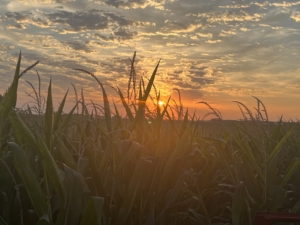
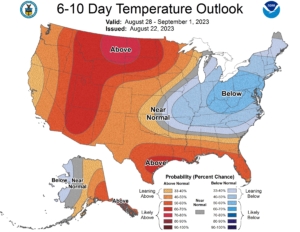
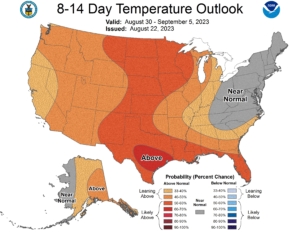

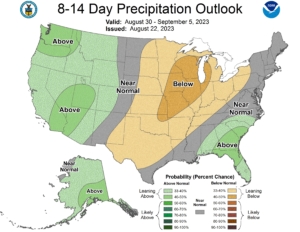
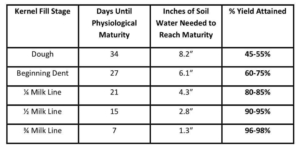 One positive is that most irrigated soil moisture profiles in the heavy soils are in good shape if irrigation has occurred over the past week….this means not that many circles are left, but we don’t have enough in the profile to finish the crop like we would want it to finish. At R6, soybeans still need 2-3 inches of water to finish and they have been pulling harder than corn. All of these figures are dependent upon temperature and humidity.
One positive is that most irrigated soil moisture profiles in the heavy soils are in good shape if irrigation has occurred over the past week….this means not that many circles are left, but we don’t have enough in the profile to finish the crop like we would want it to finish. At R6, soybeans still need 2-3 inches of water to finish and they have been pulling harder than corn. All of these figures are dependent upon temperature and humidity.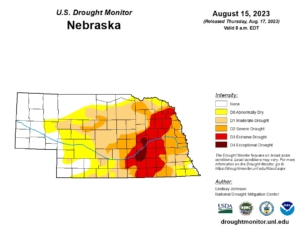
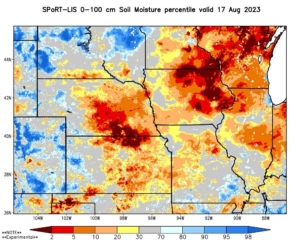 These two maps show the latest drought monitor map for Nebraska and soil moisture percentile deficit for the western corn belt. While this is just FYI, please note that, while drought conditions have improved, our subsoil profile overall is still below normal for much of Nebraska and Iowa and the north eastern corn belt.
These two maps show the latest drought monitor map for Nebraska and soil moisture percentile deficit for the western corn belt. While this is just FYI, please note that, while drought conditions have improved, our subsoil profile overall is still below normal for much of Nebraska and Iowa and the north eastern corn belt.